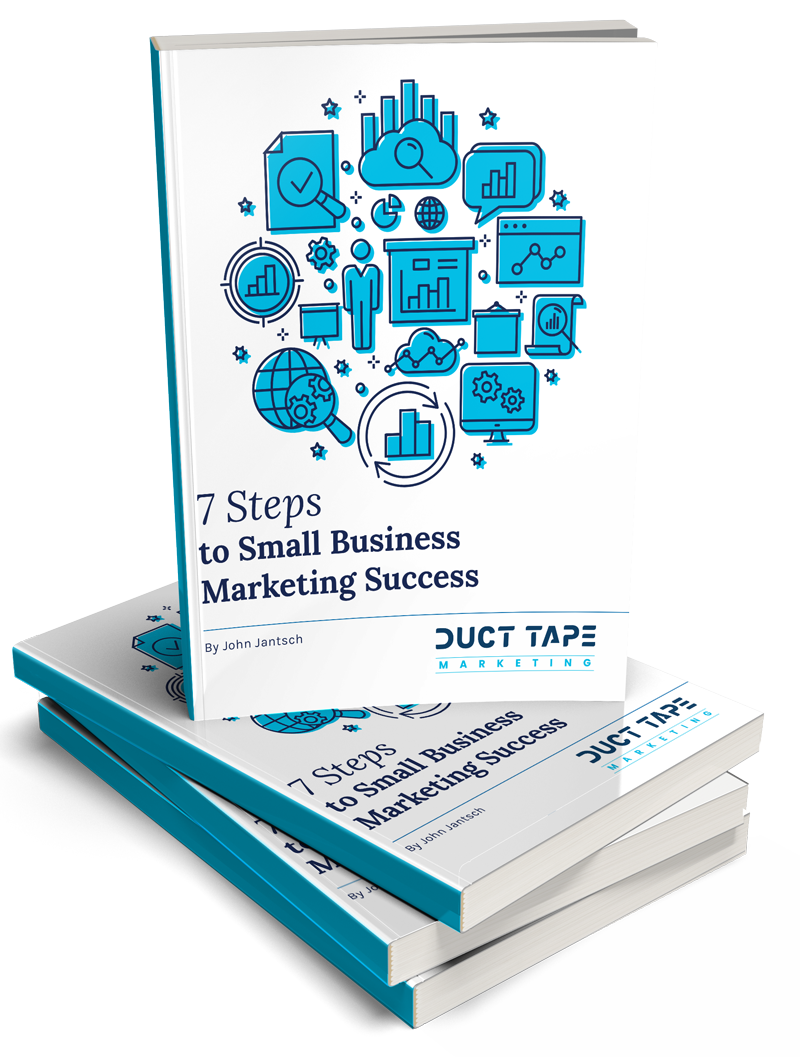Marketing Podcast with John Jantsch on 2020 Small Business Marketing Insights
I wanted to close out the year with a solo show looking ahead to the next one; let’s talk small business marketing insights for 2020.
While there have been some big trends in the world of marketing—things like AI—getting a lot of buzz, I’m not here to talk about those. Trends like that are often not relevant to small business owners. Instead, I want to cover what I think are the insights for 2020 to give you some things to think about, that can actually add to what may be your long list of planning elements.
Insight 1: Audio Content Will Prevail
I think audio content is going to be something that people need to really embrace for 2020. If you’re not podcasting already, now is the time to start. It’s a great way to produce content. It’s also a great way to open up lines of communication with people you want to speak with, whether those are authors and influencers or folks in your target market or even your very own customers.
So podcasting is a great way to build relationships. But beyond that, the format appeals to the needs and sensibilities of a modern audience. People have less time and attention to sit in front of a monitor and read content. I certainly know I’m that way! Same with video. I have a lot of trouble sitting in front of a monitor and devoting time to a video when I could be doing other things.
Audio content, on the other hand, is totally portable. I can download a podcast, stick my phone in my pocket and go for a walk. I can turn it on in the car and listen during my commute. I can walk the dog, I can go for a run. The portability of the format makes it incredibly easy for even the busiest of people to consume the content at some point during their day.
So, if you are not producing audio content, I’m going to encourage you to do so. And there are a number of ways to get started. If you have videos you’ve already produced, you can strip out the audio from those videos and run it in another format. You can use audio to talk about your business, then get the audio transcribed and use that on webpages as written content.
And you can create a non-traditional podcast. It doesn’t have to be all guest interviews. You can occasionally do a rant (like this one I’ve done on marketing insights!) to get results.
Getting started with audio now isn’t just about getting immediate results—it’s also about the long game. I see smart speakers eventually playing a bigger role in the way people consume more of their daily content. So “Alexa: play my flash briefing,” might deliver a daily recap of audio content. While I think this is a ways off, it’s never to early to get prepared for a shift like that!
Insight 2: Take Your Marketing In House
As a marketing consultant and person who trains marketing consultants, I think more small businesses should bring things in house. And there’s two areas in particular that should be outsourced less: marketing tactics and technology.
In the case of both of those areas of focus, it’s not an either-or proposition. You hire a marketing person to handle routine things that include both sides of that coin, from writing content to doing social posts to getting reviews to making Instagram posts. Those are all things that I think you should have an internal resource to do, but the secret ingredient is to marry that with a strategic marketing partner.
A lot of times, small businesses will hire a marketing person who knows how to manage social media, but isn’t given any broader direction when it comes to marketing strategy. (And that’s because there often isn’t a bigger strategy.)
That’s where a marketing consultant or advisor comes in. They can help you with the strategic component, the plan, the operations of the plan, the analysis of results, and make sure that you remain on track in working towards your big goals. Meanwhile, the internal person who knows the intricacies of the business can be directed to execute on this plan and craft messages that align with your strategy. That way, you get the best of both worlds.
In fact, I think this is going to be so critical in 2020 that we’re creating a certified marketing manager program, where we’ll train small business marketing staff on how to hire internal people and have that person directed by an outside resource, like a Duct Tape Marketing Consultant.
Want us to train your people while you grow your business? Check out the Certified Marketing Program here and schedule a free coaching session to learn how this program can work for you.
Insight 3: Humanize and Automate
Remember how back in the day, every deal was done with a handshake with a trusted partner you could look in the eye? Then technology came along, and suddenly you could do business without ever actually speaking with another human being. Now, it seems the pendulum is starting to swing back the other way, and we’re finding a happy medium.
So this insight sort of seems counterintuitive, but I’m saying you need to both humanize and automate. It comes down to finding the right balance. Both customers and business owners want things to be convenient and efficient—which is where automation comes in—but they also want that human touch.
There’s a tremendous amount of research being done around what makes someone love a company. And in many cases it’s things like convenience, knowledge, communication, efficiency, friendliness—all human traits. But a lot of the reasons a company is convenient and efficient are now aided by technology.
So I think that we need to get to the point where we are automating everything that can and should be automated and we are humanizing or re-humanizing everything else. My insight for 2020 in terms of a recommendation in this case, is get back on the phone. Let your phone ring, answer your phone, call people, that is one of the easiest ways I think to re-humanize our businesses. I’ve certainly been guilty of the opposite, and I look forward to picking up the phone more this year.
Insight 4: Focus on Customer Experience
Customer experience and retention is the golden opportunity for every single business.
PwC did extensive research into why customers stay loyal. They found that very few reasons had anything to do with the actual product or service. For the most part, it was all about customer experience—things like convenience, knowledgeable communication, efficiency, and a friendly staff.
So, how can we look at this in our marketing? You’ve probably heard me talk about the marketing hourglass, where we get people to know trust, try, and buy. But then we think marketing ends at the repeat and refer stages.
In reality, though, all seven stages must come together under the marketing umbrella. Everything from building knowledgeable, efficient communication to reporting results and providing friendly interactions for customers all go hand-in-hand.
I think we as marketers ought to spend at least half our time on creating a better customer experience and then you can spend the other half on generating more leads and converting more leads.
Insight 5: Paid Search Matters More Than Ever
Paid search—Google ads, Facebook advertising, LinkedIn, all the banner ads—have been around forever. So it’s not their existence that’s a new insight. In fact, certain types of businesses, like e-commerce brands, have used paid search to dramatically grow their businesses. But we’ve now entered an era where the small local business of any stripe must embrace paid search. Increasingly, Google is where people turn to find any and every piece of information about a business. Even if they’re already a customer!
An interesting anecdote for you: I did a search the other day for a plumber in Kansas City. And the first real result, meaning an actual business that wasn’t either an ad or an aggregator like Angie’s List or Home Advisor, showed up on page two. So, pay to play is definitely here. Making paid search a real, significant part of your overall marketing plan is no longer optional.
My first bit of advice on that front is to make sure you’re involved in the paid search process and are doing it in a smart way. Do your research about what paid search actually entails. You don’t have to do it for yourself, but you need a baseline knowledge to know you’re not getting scammed.
I see so many small business owners that work with pay per click firms that basically set up templated campaigns and forget them and don’t communicate and just say, “Oh, you got 27 clicks this week”. Well what does that mean? It means I spent X amount of money, that’s all you can tell me. It’s not about how many clicks you got, it’s about how many customers you won.
My next piece of wisdom is the use paid search to capture people with the highest purchase intent. There’s a lot of categories of business where paid searchers converted two to one over people that just went out and had a long tail search and found your blog post.
I’m not saying abandon everything else. In fact, never abandoned your website, SEO, or content. But you want to supplement it with paid search to get that high intent stuff. Maybe there’s categories where you’re having trouble getting your content to rank. Maybe there are certain really competitive search terms like an emergency service for something that you know if somebody finds your ad they’re going to buy it, because they’re trying to fix something.
I believe that the local service ads are going to only get bigger as a category. Eventually, you’re going to find accountants, lawyers, and more in those service ads because Google is making more money on those ads than anywhere else. And, consequently, the ads are going to take up more real estate on the results pages.
One final note on paid search: if you set your campaigns up correctly and are checking in on reports regularly, you come to understand that you’re not really bidding on keywords. You’re bidding on search terms: what someone puts into a search term to make your name pop up.
Once you begin thinking of things in those terms and use analytics to track your results, then you can build a complete roadmap for your marketing plan. When you understand the tactics that are working, and how people are moving throughout their customer journey from start to finish, then you can tailor your content further to encourage others to take that same path to conversion.
Those are my five insights for 2020. I hope you get out there and make moves to implement some of the tactics around these insights, because I really do believe they can make a huge difference in your marketing.
To help you in your marketing efforts, I wanted to announce that—while I don’t have a release date yet—you should keep your eyes peeled for a significantly revised edition of Duct Tape Marketing, the original book. Also, we’re creating a certified marketing manager program, which should be launching at the end of Q1 2020. The program will allow business owners to provide personal development and training to their team. You’ll have your own private coach or consultant, and they won’t just go through the plan, but will also apply the plan to your business.
So keep an eye out for all that and more in 2020. Take care and have a great rest of your 2019. See you in the New Year!
Like this show? Click on over and give us a review on iTunes, please!

This episode of the Duct Tape Marketing Podcast is brought to you by SEMrush.
SEMrush is our go-to SEO tool for everything from tracking position and ranking to doing audits to getting new ideas for generating organic traffic. They have all the important tools you need for paid traffic, social media, PR, and SEO. Check it out at SEMrush.com/partner/ducttapemarketing.



